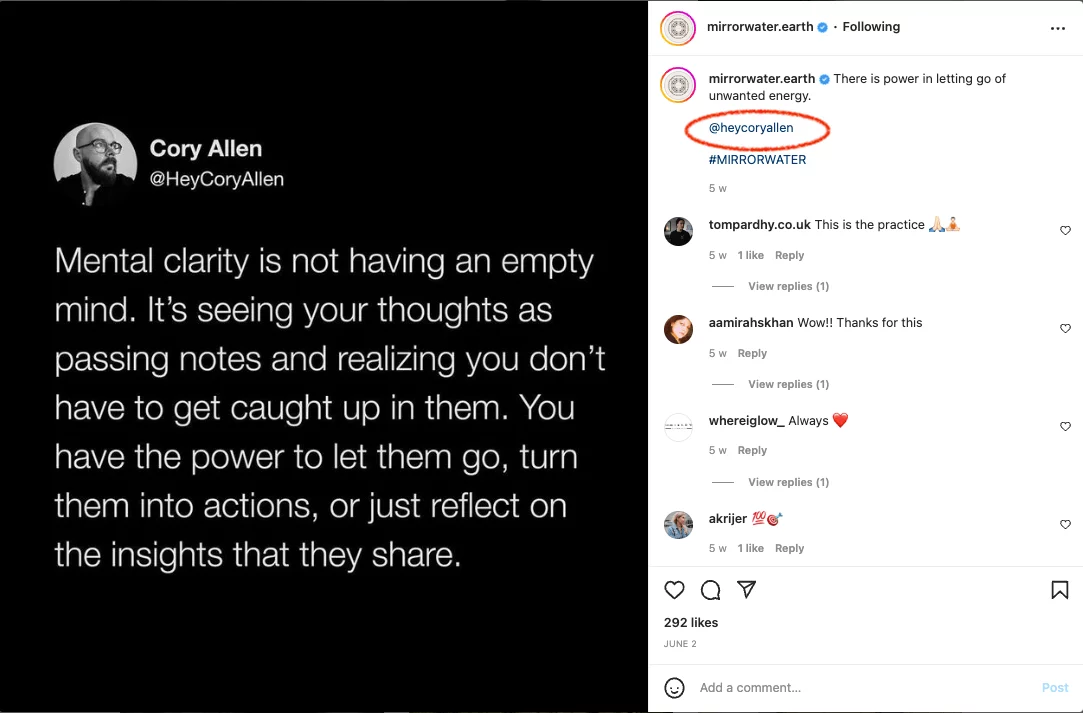Why do you need a social media strategy for your business? After all, you’ve got a ton of to-do lists to get through and targets to meet. Your time is precious, and you’re beginning to feel overwhelmed by it all!
If you’re looking for a way to increase website traffic, build brand awareness, and generate leads, you need to have a solid plan in place.
Attracting more customers and creating more sales is essential for a successful business. Without a social media strategy, you’ll have no way to coordinate what your audience sees about your brand online or when.
So here’s my guide to creating a tried and tested social media strategy:
2. Perform a competitor analysis
4. Get to know your target audience
10. Interact with your followers
What is a social media marketing strategy?
A social media strategy is a detailed action plan that outlines the steps to achieve your social media marketing goals. This master plan contains everything from your list of social media channels and promotion tactics to the responsibilities of the social media team and the metrics you will track.
Social Media Managers create a strategy for each client or brand they work with. The document acts as a roadmap with milestones to chart the progress for their long-term plan. This helps focus their marketing efforts on accomplishing the organization’s goals and vision.
Use our social media strategy template to follow along.
Why you need a social media marketing strategy
Planning your social media campaigns in advance will help save you time and create a consistently strong digital presence across all your marketing channels.
Identifying your business objectives, social media marketing goals and target audience will help you create the right type of content to generate positive results.
A social media strategy will help to:
- increase brand awareness and reach new audiences on each social media platform
- nurture customer loyalty
- provide proactive customer support
- attract inquiries and convert leads into sales
A solid plan will ensure you get the best return on your social media marketing efforts.
How to create a successful social media strategy: 13 fundamental steps
Creating a social media marketing strategy shouldn’t be overwhelming. It’s a great opportunity for you to think ahead and shape your business online.
1. Run a social media audit
This is an important step that allows you to take stock of how your social media marketing plan has been performing.
Your social media audit will be an honest review of what’s been working on each social media channel and what hasn’t. You can do a full audit on Instagram only, or for all the social media platforms together.
Use this time to understand your strengths and weaknesses online so that your new social media marketing strategy can build a clear path ahead.
How to conduct a social media audit:
- write down all the social accounts you own
- add your basic statistics, including follower counts, how long the account has been running and who’s responsible for it
- check that you have consistent branding and tone of voice across all your social networks
- review all your contact information and bios – are you making the most of these fields?
- check that all the links you use in your bios work properly
- research which types of interactions have been the most successful – posts, reels, stories, product types?
By collating all your social media data and reviewing it, you’ll have a much better idea of how to plan ahead.
For example, you may see that you get great engagement for Instagram reels but not for Instagram stories. Alternatively, you might find that certain topics get shared more by your followers than others.
Understanding how your content has been performing is key to creating your social media strategy. Create the social media content that you know your followers will enjoy for great results all year round.
2. Perform a competitor analysis
You might think you know everything about your competitors or you might not have given them much thought at all. Carrying out competitive analysis is a vital step in forming your own social media marketing strategy.
If your customers can’t get what they want from you, they will go elsewhere!
So, who are your competitors?
- identify products and services online that are similar to yours
- review the social media accounts of businesses like yours – what do they tell you about the company?
- look for additional information from Google Trends, and read newspapers and business reports. Be inquisitive!
- use search engines for specific queries that your customer might use, such as the ‘near me’ query
The important thing to remember about competitive analysis is that if you’re checking out the competition, they’ll undoubtedly be checking you out too!
3. Set social media goals
Defining some clear social media goals will be helpful in charting your progress from new kid on the block to confident social media strategist! But where should you start?
Examples of social media goals:
1. Increase brand awareness
- number of followers
- post impressions
- mentions and shares
2. Generate leads
- conversions from social media
- downloads
3. Increase revenue
- signups
4. Drive traffic to the website
- traffic from social media
- clicks on social media posts
- trials
When you create a social media strategy, it’s easy to get caught up in “vanity metrics”. Fervently checking how many followers and likes you have might seem an obvious way to monitor success but be wary. These particular social media measurements may not always paint the full picture. Ask yourself whether these followers are real and whether you’re converting any of them into paying customers.
Your social media marketing goals and business objectives need to talk to each other. Gaining lots of followers but not increasing your sales is a clear indicator that there’s still work to be done.
Look for specific indicators that will identify how often your brand is getting noticed and the type of actions your followers are taking.
Aside from understanding the reach and engagement your posts achieve, examine your conversion and click-through rates, particularly when using social media ads.
For example, if you’re checking how many people watch your videos online, look for those that have watched the whole video rather than just a few seconds. Get your followers to watch your videos to the end, and you’ll improve your ranking with social media algorithms. If you’re struggling with video creation. there are several video marketing tools that can help you with video creation, like Animaker or Adobe Express.
Likewise, focus on getting followers to complete a call-to-action on each post, reel, or story (like, share, save, sign-up). Actions signal positive intent to the algorithms and give you measurable data toward your social media goals.
In order to create a thriving social media presence that generates income for your business, think carefully:
- Is each call to action clear to your social media followers?
- How many shares and saves do you get on your social media platforms? These types of actions require specific engagement from an active community
- How many products do you need to sell via social media for your social media marketing strategy to be a success?
4. Get to know your target audience
Let’s look at your target audience demographics. Who, realistically, is going to be most interested in what you have to say? Not everyone is going to relate to the problems you solve or want to buy your products. But if you could hand-pick your customers, who would they be? What would they want from you?
Getting to grips with your audience demographics will help you to get to know your customers and where to find them:
1. Use (native) audience insight tools
2. Find out where your audience is most active
4. Identify or create buyer personas
Start by creating an ideal customer persona and describe everything about them. From where they live, what type of job they have, down to their income, hobbies, and aspirations. Getting ‘under the skin’ of your customers is a useful tool in generating social media content and anticipating how they’ll react.
Once you understand exactly who your target audience is, it will make creating social posts much quicker and easier.
5. Choose the right channels
How do you choose which social media channels to use? If none of your target audience uses LinkedIn but loves to pin posts on Pinterest, then building a LinkedIn strategy may not be the answer. Perhaps your audience is more local to your business, and generating inquiries from Facebook users in a community group is more useful for your business.
To learn where your audience hangs out, there are some simple steps you can take:
- Create an ideal customer persona
- Search the social media channels you’re considering using to see if your competitors are there
- Search for relevant industry hashtags and see what conversations are taking place on each platform
For example, when doing marketing for SaaS companies, like for a tech-heavy B2B, you’ll need to pinpoint the right platform to address the niche of professionals that make up their audience.
6. Pick your topics/categories
Research the types of educational content that your followers would be most interested to receive from you. Are they looking for tips and ideas, money-saving offers or the latest research and product information?
Your winning social media strategy should contain a list of topics and categories that you’ll use to create content throughout the year. You can categorize them into three types: “How To”, guides and “What Is …” These content pillars will help demonstrate your authority and knowledge of your sector.
Think about the following:
- What pain points does your ideal customer have?
- Which keywords are important to your followers?
- What can you teach your target audience?
Once you understand what your content pillars are, you’ll find lots of different ways to connect with your followers. They’ll see your brand as relatable and aligned with their needs.
7. Establish a schedule
Creating a consistent social media presence is key to showing up in your followers’ news feeds. A social media calendar helps you to plan ahead and organize your social media posts so that they’ll have the best chance of being seen.
Many marketers will create a social media content calendar to manage all their planned social media posts, videos and stories. These usually include:
- publishing date and time
- social media platform
- post format (reel, story, youtube short)
- post copy
- visual (image, gif, video)
- hashtags
- location tag
Planable’s social media content calendar will schedule and publish your content automatically to 7 different platforms: Instagram, TikTok, Youtube, Facebook Twitter, Google Business Profile and LinkedIn. With Planable’s visual posting schedule layout, you can see exactly when your social media content will be published on each of the social channels.
8. Define your workflow
If you’re part of a social media team, it’s important to have a strategy in place to determine how you will work collaboratively. Make sure everyone knows what their roles are and what’s expected of them. From creating and approving social media content to publishing and analyzing post-performance, there’s a lot to organize!
A smooth approval process ensures:
- streamlined and timely collaboration
- error and typo-free social media copy
- consistent brand voice
- continuous learning of client preferences
- zero missed deadlines
Planable’s social media approval process means that you have the option to make sure that nothing goes out live to your social media networks unless it’s received approval from your marketing team.
No one wants to see draft posts being accidentally posted or embargoed information being launched with the wrong details or on the wrong social media network!
9. Create content
A social media strategy is used to plan out all the different types of content that your business will create and publish online. It lays out how your social media team will work together and the different social media networks that you will use.
The content creation stage is so complex it’s easier to look at it as 2 phases:
1. Content creation
Creating content means producing any type of content for marketing purposes. More recently, it’s become the term used when creating post content specifically for social media, websites, and email marketing. It can involve creating quality content in different mediums, including a combination of graphic design, photography, video, and copywriting.
- how-to guide
- industry insights
- original videos
2. Content curation
Curating content means gathering pieces of content from different sources to offer additional value to our social media strategies. We use these curated items to give broader depth and meaning to our own content and to strengthen our brand voice.
- niche blog posts
- social media hashtags
- Facebook groups
- Slack communities
- Twitter communities
- experts on LinkedIn
- sub-reddits
- Quora threads
- industry newsletters
- podcasts
- user-generated content (UGC): testimonials, reviews, customer photos, mentions from your social media advocates
- content repurposing
By scheduling content in advance with Planable’s content calendar, you can add authentic and authoritative information from reliable sources. This helps to establish a better connection with audiences on your social channels. Examples might include user-generated content, testimonials, or articles published in a leading publication.
10. Interact with your followers
“Every good conversation starts with good listening,” but a conversation isn’t a conversation unless both parties interact. Knowing how and when to communicate with your followers is an important step in your social media strategy. If you’re running a real estate page on social media, communicating with your followers is essential to building a strong and engaged community. And you want to have this in your real estate marketing strategy!
The way you use social media engagement is important in your digital marketing and will help you improve your connection with your audience. Social media customer service is a valuable tool in providing helpful information and advice to remedy any service issues.
By listening and replying to your followers’ social media comments, you’ll understand their needs better while increasing your brand awareness.
There are a few tried and true engagement drivers that help social media marketers interact directly with followers:
- responding to comments
- asking questions
- posting statistics
- running contests
- using stories and Reels to hype important events
- directing website users to social media platforms
This is the step that brings your brand voice out into the open! How do you want your brand to sound on social platforms? Will you be light-hearted and youthful or professional yet friendly?
Think ahead and plan out answers to frequently asked questions. Agreeing on some stock answers will help save you time and speed up your response time to followers.
Asking questions, creating a quiz, and setting polls is a great way to interact with your target audience. The feedback you receive will help you to improve your social customer service and future social media strategy templates.
11. Work with influencers
Influencer marketing is about working with someone who has already established a large social media following to help promote your brand to their followers. The publicity they can generate for you is a useful marketing tool.
- affiliate marketing
- celebrity endorsement
- paid advertising
Social media influencers are often people that are known for being an expert or celebrity, in their niche area.
View this post on Instagram
If you’re considering using influencer marketing to promote your brand or for other marketing strategies, it’s vital that you establish their credentials first. Beware of accounts with thousands of fake followers who promote themselves as social media influencers.
12. Measure results
Your social media content strategy must be accountable. Simply creating and publishing content to your social networks isn’t enough to make it successful. When you measure performance, you discover what’s working and what isn’t.
Key performance indicators are the measurable metrics that indicate whether your content is achieving the aims set out in your social strategy.
When you’re trying to justify your social media budget with your boss, these measurements will help demonstrate your ability to track performance and progress:
- what is the typical reach of your social media content?
- how much have your social media accounts grown?
- are your followers engaging with your content?
- how has your conversion rate grown over time?
- do your content strategy and social presence align with your business goals?
You can measure your social media results by using valuable insights from each social network. Your social analytics should help chart your social media success and highlight the best social media strategies to use going forward.
13. Make tweaks
Always be prepared to make tweaks and adjust your marketing efforts. Sometimes your business goals need to be adaptable to allow for unforeseen circumstances.
- measure your success
- audit your performance
- test out new hypothesis
An effective social media strategy should be responsive. Build on your successes and learn from the things that didn’t go well. Your social media analytics will guide you, but be open to feedback from all your social efforts.
Your ideal customer persona may change over time or your product range may become larger. Constantly look at ways of creating content that’s fresh and engaging. Always be open to exchanging new content ideas that will help drive traffic and encourage your audience to become loyal followers of your brand.
Ready to launch your social media strategy?
If you’re serious about creating a successful social media plan, it pays to think ahead. Make sure your content is optimized for your social media platforms. Think about who your customer is and what they want from you. Carry out a social media review to understand the social media landscape in front of you and decide what type of content formats you want to use. Use a social media management tool to simplify the process of scheduling, publishing, and approving your content.
Don’t forget to analyze your content marketing results and tweak your social media campaigns so that you can get the very best results from your efforts.
Joanna Aitkens is the founder of Aitkens Media Ltd., an international social media marketing agency based in the UK. She has over 25 years’ experience as a freelance writer and journalist. Joanna is also a respected guest speaker and has appeared at various events to discuss the impact of social media marketing and the evolution of business communications.











